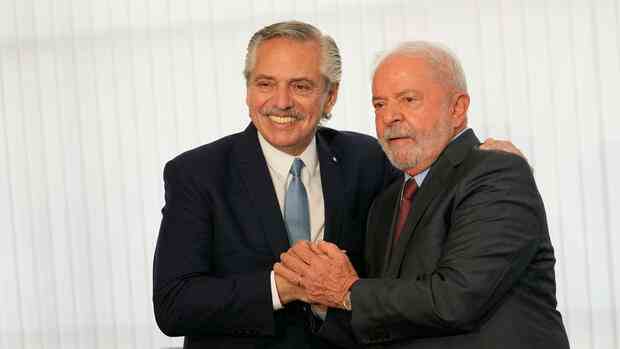A statement that has made international headlines ever since. Because this could create the world’s largest monetary union after the EU – should all Latin American countries adopt the currency. Five percent of the global gross domestic product (GDP) is generated in the region. In the EU it is 14 percent of global GDP.
According to Massa, the name of the currency has already been considered. Brazil suggested “Sur”, which means “south” in Spanish. “I don’t want to raise false expectations,” emphasized the Argentine. “But it is the first step in a long journey that Latin America must make.”
In fact, Lula and his Argentinian counterpart, Alberto Fernández, outlined a similar plan in a recent opinion piece. However, the plans there sounded far less ambitious. A currency is to be created that is primarily intended to serve as a unit of account. The local currencies real and peso should continue to exist in parallel.
Top jobs of the day
Find the best jobs now and
be notified by email.
The aim is to increase the shrinking volume of trade between the two largest economies in South America, the presidents said. “We want to reduce operational costs and external dependency,” they wrote.
There are nearly two dozen different exchange rates to the dollar
In South America, however, the announcements attracted little attention. Ever since the first integration projects in South America 50 years ago, the common currency has fired politicians’ fantasies time and again – but the attempts never got beyond material for academic work.
The Brazilian-Argentinian economist Fabio Giambiagi criticized the renewed discussion as a “waste of time”. According to Giambiagi, the lack of state planning of the economies by the governments and the different economic situations in the two countries prevent the development of a serious currency project at this point in time.
>> Also read here: Free trade for free countries – Lindner launches push for global trade alliance
The legitimate question is: How is a common currency supposed to work in a region where the countries don’t even form a free trade area – let alone a common market?
Brazil has a floating exchange rate and an independent central bank. Argentina’s central bank is printing money on orders from the president to help balance the budget deficit. As a result, the peso amount has quadrupled in his three years in office. Inflation in Argentina is 95 percent a year. In Brazil it was almost six percent in 2022.
Brazil has more than $300 billion in foreign exchange reserves, making it a creditor to the global financial system. Argentina’s foreign exchange coffers are almost empty. The government is using rigid capital controls to prevent Argentines from buying dollars.
There are around two dozen different exchange rates to the dollar. On the black market, the dollar is worth around twice the official rate. The country also owes more than $40 billion to the International Monetary Fund.
And the trade flows between the two countries have also lost importance: just under five percent of Brazilian exports go to Argentina. Both countries have primarily become agricultural, energy and raw material suppliers for China.
Mercosur is little more than a holey customs union
There is no common market, not even a free trade zone. In Mercosur, the economic community between Argentina, Brazil, Uruguay and Paraguay, there are numerous products and services whose imports are subject to high tariffs. To this day, the confederation of states is not much more than a holey customs union. Economic integration is even less advanced with the other economies of South America.
For economist Giambiago, only the attempt at a common accounting unit in Latin America could make sense. “But there is already a dollar that works perfectly with it,” says Giambiago. It is also already possible to pay for imports and exports in local currency. Giambiagi asks why reinvent the wheel with a Southern dollar.
>> Also read here: For the first time in 200 years: Brazil’s largest state bank gets a boss
It is probably primarily a political reason why a common currency is now being discussed again. After his re-election, President Lula wants to promote political and economic integration in Latin America. Brazil concentrates more than half of the economic power and population of the double continent. With unity in the region, Lula wants to increase Latin America’s geopolitical weight in the world – just as he did in his first two governments.
It is fitting that Lula confidante and Finance Minister Fernando Haddad published an article on the subject with Gabriel Galípolo, his most important State Secretary, back in April last year. According to this, the common currency “Sur” is to be issued by a South American central bank, but not to replace the existing currencies.
They define the task of the “Sur” as follows: “It should accelerate the process of regional integration and create a strong instrument for political and economic coordination in South America.”
And the advance of the Argentinian economy minister Massa can also be interpreted politically: The minister thinks he has a chance of standing in the presidential elections in October. But in order to convince the electorate, he has to come up with success stories in the midst of the severe economic crisis. The “Sur” should be one of them.
More: Brazilian President Lula reappoints head of army
